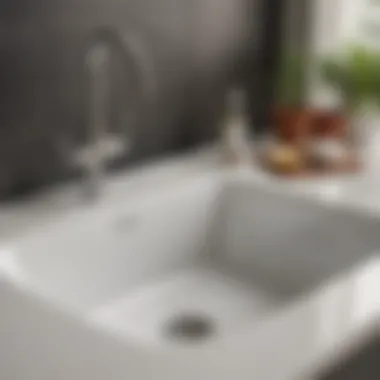Effective Methods for Unclogging Your Kitchen Sink


Intro
A kitchen sink is an essential fixture in any home. It plays a critical role in food preparation, dishwashing, and even cleaning tasks. However, a clogged sink can disrupt daily routines and lead to frustration. Understanding how to effectively address clogs in a kitchen sink is indispensable for homeowners. This knowledge allows individuals to act swiftly and efficiently in rectifying such nuisances.
Clogs can stem from various sources, including food debris, grease, and foreign objects. Choosing the right approach to unclogging a sink often depends on the severity of the blockage and the materials available at hand. This article aims to clarify the most effective strategies for unclogging kitchen sinks, encompassing both chemical and natural solutions. In addition, it focuses on important preventative measures to avoid future clogs.
By empowering readers with detailed insights into unclogging techniques, this guide is set to enhance not just the functionality, but also the overall aesthetic appeal of kitchen spaces.
Understanding Kitchen Sink Clogs
Understanding kitchen sink clogs is essential for maintaining overall household functionality. These clogs can disrupt daily routines, causing frustration and inconvenience. Recognizing the different causes and signs related to clogs helps homeowners take appropriate action before problems escalate. This involves not only the immediate resolution of clogs but also preventative measures to avoid future occurrences. Knowing how clogs develop and recognizing their symptoms allows homeowners to address issues quickly, preserving both the function and aesthetics of the kitchen space.
Common Causes of Clogs
Kitchen sink clogs often arise from a variety of sources. Identifying these causes can lead to more effective solutions.
Food Particles
Food particles frequently contribute to sink clog issues. They can accumulate over time, especially if the sink is not properly maintained. Any leftovers from meals, including bits of vegetables, meat fibers, and grains, can build up in the pipes.
The key characteristic of food particles is their organic composition. This makes them a common choice for clog formation in household plumbing.
The unique feature of food particles is their tendency to create a sludge-like substance when mixed with water and grease, leading to significant blockages. The main disadvantage here is that these particles can compact, making them quite challenging to remove without intervention.
Grease Accumulation
Grease accumulation is another significant contributor to kitchen sink clogs. When cooking, fats and oils often find their way into the sink. Over time, these substances solidify within the pipes.
The key characteristic of grease is its ability to cling to pipe walls, gradually narrowing the passage. This makes grease a common choice for causing slow drainage or total blockages.
A unique feature of grease is that it can solidify at lower temperatures. This aspect leads to increasing friction, which may trap food particles and debris, complicating the unclogging process. One disadvantage of grease accumulation is its potential to cause severe clogs, often requiring heavy-duty techniques or chemical solutions for removal.
Foreign Objects
Foreign objects in the sink can also lead to clogs. Items like utensils, sponges, or even small toys can inadvertently wash down during cleaning or washing tasks. The key characteristic of foreign objects is their inability to break down in water, leading to instant blockages in the drain. This makes foreign objects particularly noteworthy when discussing effective solutions for unclogging. Their unique feature lies in the fact that they require immediate attention for removal, as they can suddenly halt drainage completely. The disadvantage of foreign objects is that they may require professional help or specific tools to retrieve, depending on their location within the plumbing.
Signs of a Clogged Sink
Recognizing the signs of a clogged sink can save time and mitigate more significant issues. Knowing these indicators is crucial for effective intervention.
Slow Drainage
Slow drainage is often the first noticeable indication of a clog. It manifests when water takes longer than usual to clear from the sink.
One key characteristic is the gradual onset; it's often overlooked until it becomes more pronounced. This feature makes slow drainage a popular topic in discussions of sink clogs.
The unique aspect of slow drainage is that it signals the early stages of a clog. Addressing this early can prevent more severe blockages. One disadvantage is that it may create pools of water, which can promote bacterial growth.
Unpleasant Odors
Unpleasant odors are another common sign of a clogged sink. They typically arise when food particles and grease decompose within the drain.
The key feature of odors is their ability to permeate the kitchen, potentially leading to an unwelcoming environment. This makes unpleasant odors a significant concern in this article.
Their unique characteristic is that they often come as a surprise to homeowners until they become unbearable. A disadvantage of these odors is that they may signify deeper issues that require thorough cleaning or more serious intervention.
Backflow Issues
Backflow issues occur when wastewater reverses into the sink, creating unsanitary conditions. It is a strong indicator that significant clogs exist downstream in the plumbing system.
The key characteristic here is the immediate and often alarming nature of backflow. Commonly recognized as a serious plumbing problem, it is an essential concern in this discussion.
The unique element of backflow is its health risk, as wastewater can contain harmful bacteria. One disadvantage involves the potential need for extensive plumbing repairs when backflow occurs.
Evaluating Unclogging Products
The examination of unclogging products is critical for understanding what is truly effective in addressing kitchen sink clogs. With a plethora of options available, from chemical solutions to mechanical tools, knowing which product fits a specific situation is essential. Each alternative comes with its own set of benefits and drawbacks, making it important to evaluate based on several factors, including efficacy, safety, and impact on plumbing systems. By carefully assessing these products, homeowners can make informed decisions that lead to successful unclogging and avoid potential damage to their sinks.
Chemical Drain Cleaners
Chemical drain cleaners are a popular choice for tackling clogs due to their potent formulations.


Active Ingredients
The active ingredients in chemical drain cleaners primarily consist of strong acids or bases. Common compounds include sodium hydroxide and sulfuric acid. These components contribute significantly to the breakdown of blockages, dissolving organic matter that typically causes clogs. The key characteristic of these ingredients is their ability to work rapidly, making them beneficial for immediate results. However, their corrosive nature can be a unique feature, presenting risks such as damage to pipes and harmful fumes.
Usage Instructions
Usage instructions for chemical drain cleaners generally involve pouring the solution into the affected drain and allowing it to sit for a designated time. This simplicity is an appealing aspect for many. Proper following of these guidelines ensures efficacy in unclogging, though it requires careful measurement to avoid overuse. Misuse can lead to excessive chemical buildup, potentially damaging plumbing systems.
Potential Risks
While chemical drain cleaners can be effective, potential risks should be understood. The harsh nature of these chemicals can lead to pipe corrosion, especially in older plumbing systems. There is also a risk of accidental spills, which can harm the skin or create hazardous fumes. Homeowners must weigh the immediate benefits against the long-term impact on their plumbing and health.
Natural Remedies
Natural remedies appeal not only for their eco-friendliness but also for their safety compared to harsher chemicals. They are often viewed as effective alternatives that use common household items.
Baking Soda and Vinegar
Baking soda and vinegar combine to create a chemical reaction that can effectively unclog drains. The fizzing action helps break down clogs while being safe for most plumbing. This duo is popular due to its availability and minimal cost. An appeal of this method is its non-toxic nature, making it safer for homes with children or pets. However, for severe clogs, this combination may not yield sufficient results.
Boiling Water
Pouring boiling water down the drain can assist in melting grease or soap buildup, which are common culprits for sink clogs. This method is particularly attractive because it is straightforward and requires no special products. The simplicity and effectiveness for mild blockages make it a frequent go-to option. One limitation is that this approach is not suitable for every type of clog, especially if it is caused by solid foreign objects.
Enzymatic Cleaners
Enzymatic cleaners use natural enzymes and bacteria to digest organic materials that cause clogs. Their appeal lies in the safety and environmentally friendly nature of these products. Unlike chemical cleaners, they often pose no risk to pipes. Users must be patient, as the action of these products tends to be slower than chemical alternatives. However, their long-term benefits in maintaining drain health cannot be overlooked.
Mechanical Methods
Mechanical methods of unclogging provide a hands-on approach that can often eliminate issues without the need for chemical assistance. These methods vary in effectiveness based on the severity and nature of the clog.
Plunging Techniques
Plunging techniques involve the use of a plunger to create suction and dislodge clogs. This method is a classic in unclogging practices due to its straightforward application. It is often the first step homeowners take in tackling a sink issue. One downside is that this technique may not work for every clog, particularly stubborn or deep-seated blockages.
Snake Tools
Snake tools, or drain snakes, are effective in reaching deeper clogs that a plunger cannot affect. A unique feature of this method is its precision. By directly addressing the blockage, these tools can often remove the clog entirely. Depending on the severity, using a snake requires some skill, and improper use can risk damaging the drain.
Hydro Jetting
Hydro jetting employs powerful streams of water to clear clogs. This technique stands out for its effectiveness in removing even the most persistent blockages without causing pipe damage. As a more advanced method, it is usually performed by professionals. Its main downside lies in the cost and need for specialized equipment, making it less accessible for everyday homeowners.
Effective evaluation of each clog solution ultimately empowers homeowners, allowing them to address kitchen sink clogs intelligently.
Choosing the Right Solution
Choosing the right solution for unclogging a kitchen sink is crucial. The effectiveness, safety, and environmental impact of various methods vary considerably. With a right approach, it not only resolves the current issue but can prevent future problems. A thoughtful selection process can improve long-term functionality of plumbing systems and help maintain overall kitchen hygiene.
Assessing Clog Severity


Minor Clogs
Minor clogs are typically those that cause slow drainage without complete blockage. These clogs can often be resolved with simple home remedies. Their typical hallmark is that the water drains but at a reduced rate. The method of choice is often vinegar and baking soda. This option is beneficial because it is easy to use and avoids harsh chemicals. However, it may not work for more stubborn clogs. The unique aspect of minor clogs is that they signal a potential bigger problem. Ignoring them may lead to future issues.
Moderate Clogs
Moderate clogs cause more notable disruption in drainage and may require more effort to resolve. The key characteristic of moderate clogs is that they can sometimes allow drainage, but the flow is significantly impaired. In such situations, using mechanical methods like plungers or snakes can be effective. These methods exert a physical force that can often break up the material causing the blockage. In this context, moderate clogs are advantageous because they often respond well to these techniques. However, they still need prompt attention to avoid escalation to severe clogs.
Severe Clogs
Severe clogs are the most challenging and demand immediate action. A key feature of severe clogs is the complete inability to drain. Often, this type of clog involves complex blockages deep within the plumbing system. Addressing severe clogs may require professional assistance or high-powered tools like hydro jetting. While these methods can be very effective, they also come with higher costs and risks to plumbing systems. Severe clogs emphasize the importance of regular maintenance to prevent their occurrence.
Environmental Considerations
Eco-Friendly Products
The demand for eco-friendly products for unclogging sinks is growing. These products typically use natural ingredients to break down clogs without harmful side effects. Eco-friendly options represent a choice that is considerate of both plumbing systems and the environment. One advantage is minimal impact on aquatic life when these products enter the drainage system. However, their effectiveness compared to traditional methods may vary.
Toxic Ingredients
Toxic ingredients in drain cleaners are a serious concern. Many common chemical drain cleaners contain harmful substances that can affect human health and pollute waterways. The primary feature of these ingredients is their efficacy at dissolving clogs. However, they pose potential risks including skin irritation and adverse environmental impact. Understanding the contents of these products is essential for making informed decisions about clog removal.
Disposal of Chemicals
The disposal of chemicals used for unclogging should not be underestimated. Improper disposal can lead to significant environmental problems. A key consideration is following local regulations regarding waste disposal. Many areas have specific guidelines for disposing of household chemicals to prevent contamination of soils and waterways. Understanding these guidelines enhances responsible behavior and community health.
Preventative Measures
Proactive strategies are critical in maintaining the functionality of your kitchen sink. Understanding preventative measures can significantly reduce the likelihood of clogs, thereby preserving the efficiency of your plumbing system. The benefits of implementing these measures are numerous, ranging from cost savings to enhanced kitchen hygiene. It is essential to devote time to these practices, as they contribute toward a seamless kitchen experience.
Regular Maintenance Practices
Routine Cleaning
Routine cleaning plays a pivotal role in maintaining a clog-free kitchen sink. It ensures the removal of food debris, grease, and other potential blockages from the drain. Regular cleaning can prevent materials from hardening or building up, which would require far more intensive measures later. This practice is straightforward and can easily be integrated into your cleaning routine. One of the key characteristics of routine cleaning is its simplicity; utilizing basic ingredients like dish soap and warm water can yield excellent results.
The unique feature of routine cleaning is its preventative nature, significantly reducing the incidence of severe clogs that may require professional intervention. However, neglecting this task can quickly lead to unfortunate plumbing headaches.
Proper Disposal Techniques
Adopting proper disposal techniques for food waste is equally important. Many homeowners do not recognize that what goes down the sink can determine its longevity. Disposing of fibrous foods, grease, and non-food items can tax the plumbing and lead to clogs. One advantage of proper disposal techniques is that they promote a longer lifespan for your plumbing, clearing away problematic items before they enter your drain.
This method also reduces the risk of creating waste that can lead to seven issues such as unpleasant odors and pest attraction. Contrarily, disregarding these practices can interrupt the flow and result in significant plumbing problems, costing more in repairs.
Usage of Sink Strainers
Employing sink strainers is a wise and practical choice for effective kitchen maintenance. These devices catch food particles and debris before they enter the plumbing system, acting as a barrier against potential clogs. The key characteristic of sink strainers is their simplicity and ease of installation, making them beneficial for anyone.
They are usually inexpensive and can be cleaned easily, ensuring ongoing utilization. They significantly decrease the chances of food fragmentation becoming an obstruction in the pipes. However, relying solely on strainers without proper cleaning and disposal techniques may not provide complete protection from clogs.
Monitoring Drain Health
Constant vigilance over your drains can prevent major issues from developing. Monitoring your drain health contributes significantly to the overall well-being of your kitchen plumbing.
Frequent Inspection
Frequent inspection of your kitchen sink's drainage can detect problems before they escalate. Check for any unusual noises, odors, or slow drainage. The key characteristic of this approach is the proactive nature of identifying issues early on. This choice is beneficial as it allows for timely solutions, avoiding costly repairs later.
Regular checks can help catch minor issues at their onset. However, neglecting these inspections may mean ignoring signs that could lead to significant plumbing failures.


Early Signs of Trouble
Recognizing early signs of trouble, such as unusual gurgling sounds or persistent slow drainage, is essential. Awareness of such symptoms will enable you to take corrective action before a clog forms. The key characteristic of this awareness lies in its capacity to prevent further degradation of plumbing conditions. Identifying early warning signs is advantageous because it allows for proactive measures rather than reactive fixes, potentially saving time and money in the long run. Conversely, overlooking these signs can lead to severe plumbing issues and necessitate complex repairs.
Repair Techniques for Recurring Problems
The section on repair techniques for recurring problems is crucial to ensuring that kitchen sinks remain functional over time. Many homeowners encounter similar issues repeatedly, leading to frustration and potential damage if not resolved correctly. Understanding various repair techniques can save both time and money, reducing the need to frequently call for professional help. This section provides a practical guide to step-by-step procedures and advice on when it may be necessary to enlist the services of a professional plumber.
Step-by-Step Repair Guide
Tools Required
Having the right tools is essential for any successful repair. A well-equipped toolbox can make the process smoother and more efficient. Basic tools for unclogging a kitchen sink typically include a plunger, a drain snake, and a bucket. The plunger is beneficial as it can effectively create suction to dislodge minor clogs. Drain snakes are useful for reaching deep blockages that are not accessible by other means. Additionally, a bucket is practical for catching any overflow that may occur during the process. These tools can facilitate a quicker resolution to clogging issues, making them popular choices for DIY repairs.
Procedure Overview
The procedure for unclogging a kitchen sink generally follows a systematic approach. Begin by using a plunger to clear simple clogs. If this does not work, a drain snake can be inserted into the pipe to break up the blockage. This step-by-step process is effective for many common clogs. Following these methods allows homeowners to address issues without seeking immediate professional assistance. However, knowing when to apply each technique is critical. Misuse can lead to further complications in plumbing systems.
Post-Repair Testing
Once repairs are completed, conducting a post-repair test is vital to confirm that the issue has been resolved. Running hot water through the sink allows homeowners to observe if drainage has improved. This step is essential, as it provides immediate feedback on the success of their efforts. If problems persist, it indicates that more serious issues may be present. Performing a thorough test ensures that temporary fixes do not mask underlying problems that need further attention.
When to Call a Professional
In some situations, despite best efforts, problems may persist. Knowing when to call a professional plumber is crucial to preventing larger issues. Homeowners should be vigilant for signs that indicate deeper problems.
Indications of Major Issues
Indicators of major plumbing issues include persistent drainage problems, strange noises from pipes, or foul odors. If regular unclogging methods fail, it is wise to contact a professional. These indications can suggest serious underlying issues such as damaged pipes or clogs that are beyond typical reach. Prompt action can prevent more extensive damage and reduce repair costs in the long run.
Potential Repairs Needed
Sometimes, recurring sink issues may point towards the need for significant repairs. Professionals may recommend services ranging from pipe replacement to complete system overhauls. Assessing the root cause of the clogs often reveals whether simple maintenance or more extensive work is necessary. Such considerations ensure that households avoid repeated inconveniences and maintain their sink's functionality.
Epilogue
In the realm of kitchen maintenance, understanding how to manage sink clogs is a critical skill for homeowners. This article has examined a variety of approaches for unclogging a kitchen sink effectively. Each solution, ranging from chemical drain cleaners to natural remedies, comes with its own advantages and disadvantages. The importance of choosing the right method cannot be overstated. Not only does it affect the immediate functionality of your kitchen sink, but also the long-term health of your plumbing system.
When considering solutions, it is essential to assess the severity of the clog. Minor clogs might require a simple remedy like boiling water, while severe clogs could necessitate mechanical methods or even the intervention of a professional. The implication of using inappropriate methods can result in damage to pipes or health hazards due to toxic fumes. Therefore, taking the time to evaluate the situation leads to better outcomes.
Furthermore, regular maintenance practices contribute significantly to preventing clogs before they become serious issues. Using sink strainers, ensuring proper disposal of waste, and conducting periodic inspections of your plumbing can save time and money in the long run.
Summarizing Effective Solutions
To recap, these effective solutions can be employed based on the nature and severity of sink clogs:
- Chemical Drain Cleaners: Useful for heavy clogs but have safety concerns. Always follow precise instructions and use with caution.
- Natural Remedies: Baking soda and vinegar can often clear minor blockages without the risks associated with chemicals. Boiling water is another simple yet effective method.
- Mechanical Methods: Plungers and snakes are practical tools that can help physically remove clogs. For persistent issues, hydro jetting may be necessary but requires professional assistance.
- Regular Maintenance: Establish a routine to check for early signs of clogs, ensuring your plumbing system remains healthy over time.
By being informed about each of these methods and their appropriate contexts, homeowners can make empowered choices that enhance the functionality of their kitchens.
Final Thoughts on Sink Care
Caring for your sink is about more than just unclogging it when problems arise. It requires forethought and a commitment to preventive measures. A kitchen sink is central to many daily activities, thus, maintaining it reflects your attention to detail in home care.
The solutions discussed in this article underscore the importance of understanding the various dynamics at play within your plumbing system. The incorporation of regular checks and maintenance can alleviate many common problems before they escalate. A proactive approach not only enhances convenience but also ensures the longevity of your sink and overall kitchen environment. The balance lies in applying the right methods, whether they are chemical, natural, or mechanical, and being vigilant about your plumbing health.
Engaging in these practices enhances not just functionality but also the aesthetic appeal of your kitchen, keeping it a pleasant space to work in.







